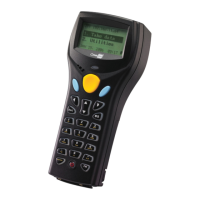98
CipherLab BASIC Programming Part I
4.9.2 COMPOSITION OF OUTPUT STRING
The mapping of the keyboard wedge characters is as listed below. Each character in the
output string is translated by this table when the command SEND_WEDGE transmits
data.
00 10 20 30 40 50 60 70 80
0 F2 SP 0 @ P ` p
1 INS F3 ! 1 A Q a q
2 DLT F4 " 2 B R b r
3 Home F5 # 3 C S c s
4 End F6 $ 4 D T d t
5 Up F7 % 5 E U e u
6 Down F8 & 6 F V f v
7 Left F9 ' 7 G W g w
8 BS F10 ( 8 H X h x
9 HT F11 ) 9 I Y i y
A LF F12 * : J Z j z
B Right ESC + ; K [ k {
C PgUp Exec , < L \ l |
D CR CR* - = M ] m }
E PgDn . > N ^ n ~
F F1 / ? O _ o Dly ENTER*
Note: (1) Dly: Delay 100 millisecond
(2) ~: Digits of numeric keypad
(3) CR*/Send/ENTER*: ENTER key on the numeric keypad
The command SEND_WEDGE can not only transmit simple characters as shown above,
but also provide a way to transmit combination key status, or even direct scan codes.
This is done by inserting some special command codes in the output string. A command
code is a character whose value is between 0xC0 and 0xFF.
0xC0 : Indicates that the next character is to be treated as scan code. Transmit it as it is,
no translation required.
0xC0 | 0x01 : Send next character with Shift key.
0xC0 | 0x02 : Send next character with Left Ctrl key.
0xC0 | 0x04 : Send next character with Left Alt key.

